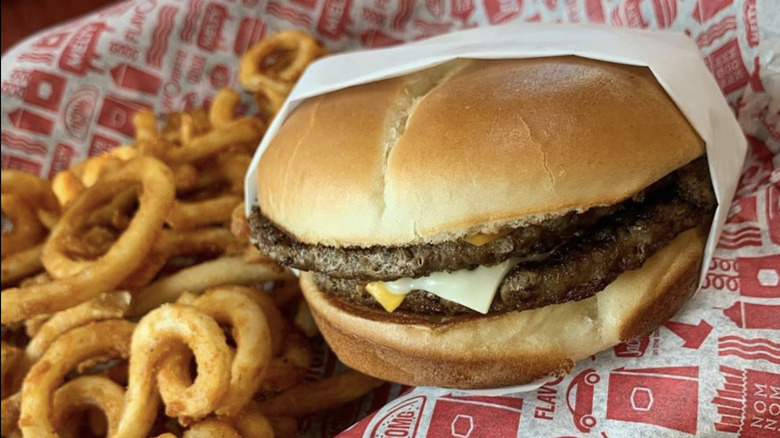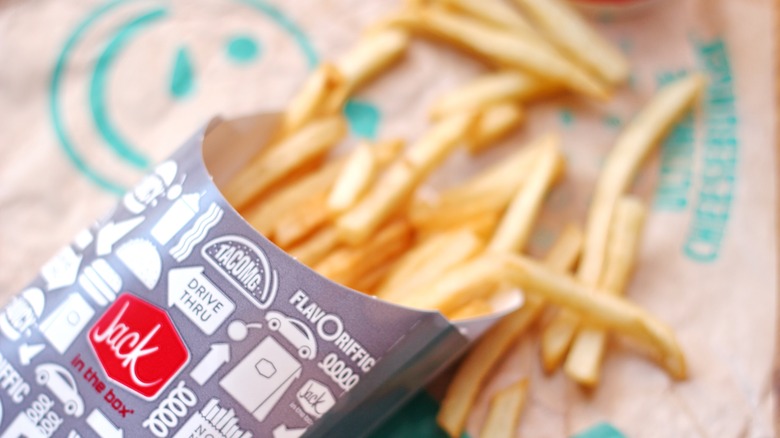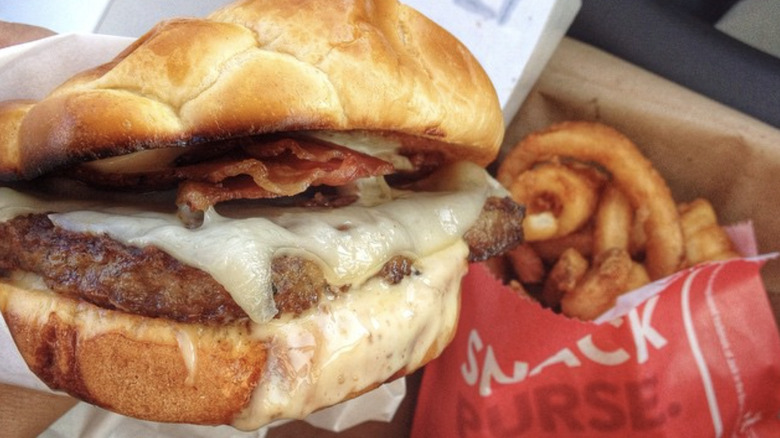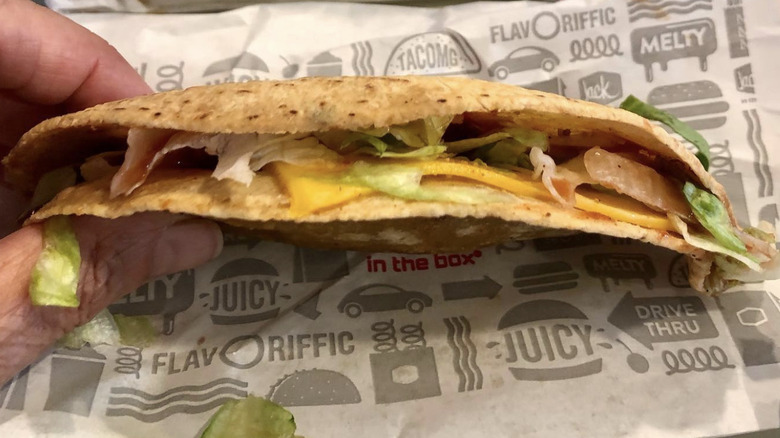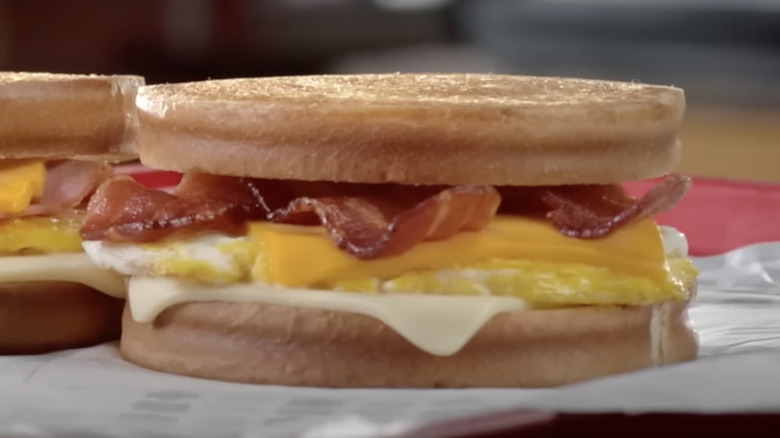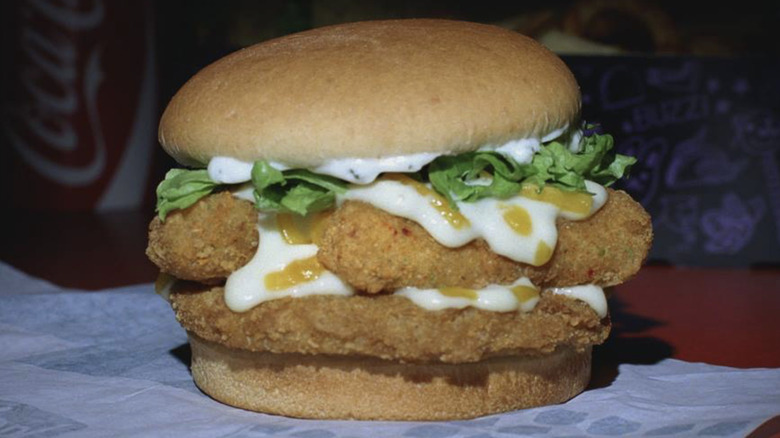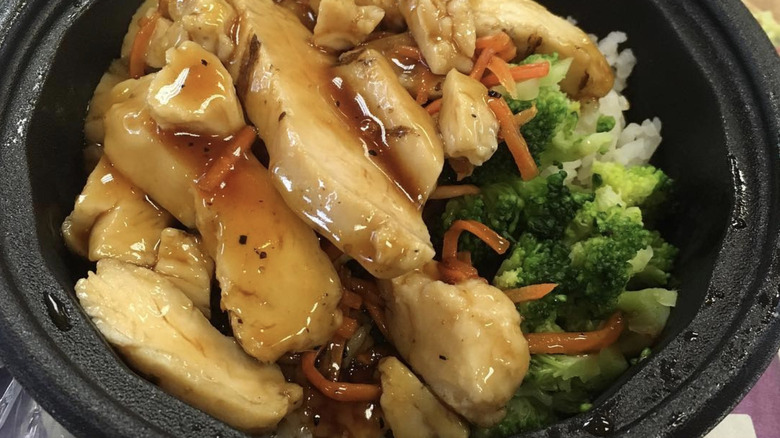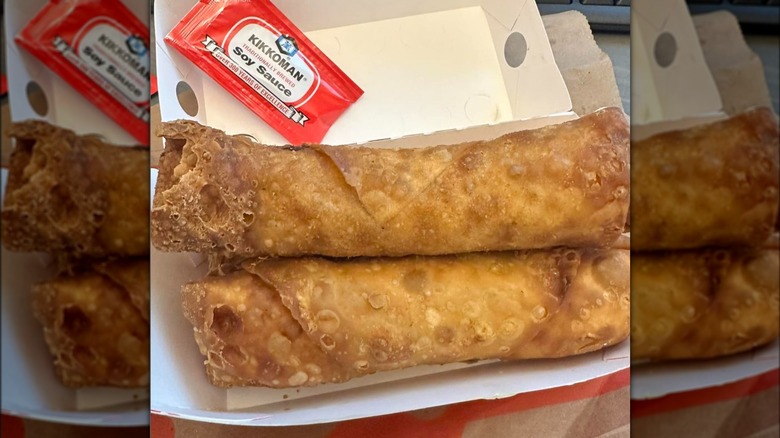Shady Things About The Jack In The Box Menu
While most of its more than 2,100 outlets can be found in the western United States, primarily in California, Jack in the Box is a national player in the fast food game. Amidst the rise, fall, and resurgence of Jack in the Box, the chain achieved that status by staying competitive, cutting costs, and offering a wide variety of traditional and non-traditional items.
Each location serves hundreds if not thousands of customers every day, and in getting out all those Sourdough Jacks, tacos, cheeseburgers, chicken strips, onion rings, Munchie Meals (and other popular Jack in the Box menu items, ranked worst to best) to the hungry and waiting, it has to make certain concessions toward quality. These aren't the kind of things it really wants the public to know about, because it can verge on the unappetizing and gross. While the food at Jack in the Box is mostly inexpensive and generally tasty to millions, it comes at a cost. Here are all the sketchy things about the creation, preparation, and makeup of the food at Jack in the Box.
The fries are full of heavy metals
Officially, the ingredient list for the French Fries at Jack in the Box includes expected things like potatoes, mixed vegetable oil, and salt, along with thickeners, sweeteners, and leavening agents. But according to the Fast Food Testing Program, conducted by the health advocacy group Moms Across America, the Jack in the Box fries are also laced with a significant and potentially dangerous level of toxic substances.
In 2023, Moms Across America released the results of its tests of samples of food from 21 quick-serve restaurants. A major takeaway: 100% of the food examined tested positive for cadmium, somewhere between 74% and 1158% higher than what the Environmental Protection Agency says is safe in drinking water. Cadmium is a heavy metal that's known to cause adverse reactions, and exposure could lead to cancer. Jack in the Box fries were a particularly egregious offender. The study indicated that the cadmium in the restaurant's most popular side item came in at a level 970% more than the EPA's water limit.
What's in the beef depends on the sandwich
At any given time, the Jack in the Box menu features more than a dozen distinct hamburgers. The chain is able to do this in an efficient manner in part because all of those different sandwiches utilize one of just two kinds of beef patties stocked in the Jack in the Box kitchen. And they're not merely different in size — the ingredients greatly vary. Jack in the Box lists just one ingredient for the "Beef Hamburger Patty, Jumbo and Regular," used in its smaller sandwiches: beef.
The "Beef Patty, ¼ lb. Signature" style, employed in the preparation of some of Jack in the Box's larger and more premium sandwiches, is mostly beef, as well as a number of fillers and flavor enhancers. Along with beef, it contains salt, yeast extract, corn maltodextrin, onion powder, hydrogenated cottonseed oil, corn starch, garlic powder, and the enigmatic "natural flavors." Those patties are even made with beef tallow, meaning that Jack in the Box uses beef extracts to make its beef taste beefier.
Jack in the Box tacos are a factory-made processed food
Jack in the Box annually serves up more than a half billion tacos, and so they're something of a cult favorite. Barely resembling the standard tacos made by American fast food companies like Taco Bell or Del Taco, Jack in the Box tacos are deep-fried and begin with a hard shell. This is then filled and almost sealed with a smooth meaty paste, as opposed to the wide-open shredded chicken or ground beef tacos found elsewhere.
Of everything you didn't know about Jack in the Box tacos, the most striking is that the meat inside isn't actually derived from any single animal or another. The filling is a factory-prepared slurry, combining heavily processed and macerated beef and chicken, along with a textured vegetable protein made primarily with soybeans that's been dehydrated and then rehydrated to wind up as a meat-suggesting substance. The taco supplies arrive at every Jack in the Box location in the form of shells already loaded with the meat concoction. Then, they're cooked to order by way of a deep fryer. After they're removed from the hot oil, a store employee adds sliced cheese, shredded lettuce, and a few bottle-squirts' worth of hot sauce.
The eggs aren't fully made of eggs
In its marketing materials, Jack in the Box has promised "freshly cracked eggs" in some of its breakfast menu items, particularly the sandwiches. However, this is a slightly misleading claim, because it doesn't mean that everything available on the Jack in the Box menu board contains real, unadulterated eggs. Products with such eggs, called Fried Eggs in the Jack in the Box ingredient and allergen breakdown, also wind up with the eggs' cooking liquid — vegetable oil with butter flavoring made from soy and dairy.
Besides the fried egg discs on the sandwiches, other breakfast menu favorites at Jack in the Box contain eggs prepared in a completely different manner and with a number of other ingredients. The Jack in the Box scrambled eggs are a careful concoction of complete eggs with extra egg whites and water, which comprises a substantial 19% of these eggs. Also added to the mix are salt, a coloring agent, butter flavor, butter-flavored vegetable oil, and xanthan gum.
The meat is full of antibiotics, even after Jack in the Box claimed it stopped adding them
In December 2016, Jack in the Box announced that it would curb the use of antibiotics by its poultry suppliers. After competitors in the fast food sphere like Panera, Chipotle, Taco Bell, Wendy's, Subway, Chick-fil-A, and McDonald's all made similar pledges, Jack in the Box promised that by 2020 it would phase out antibiotics in the raising of the chickens that eventually became its chicken sandwiches and chicken strips. The use of antibiotics in animal feed is intended to help prevent the spread of disease and allow animals to grow to usable maturity quicker. But according to some public health advocacy groups, overuse of antibiotics can also lead to the development of antibiotic-resistant superbugs or virulent bacteria that can sicken animals and humans alike.
While fast food industry antibiotics may be a bigger problem than you thought, Jack in the Box evidently didn't keep its promise to get rid of the additive. In a 2024 study released by the U.S. Public Interest Research Group, Jack in the Box was one of about a dozen major chain restaurants to score an "F" letter grade — meaning its suppliers are still routinely using antibiotics in protein production.
An expensive menu item is entirely microwaved
One of the most unique items on the menu of the otherwise burger-and-fries-forward Jack in the Box is the Chicken Teriyaki Bowl. It's also one of the more expensive things customers can get at Jack in the Box — it costs an average of just under $10 in the U.S., more than a hamburger-based combo meal but comes without fries and a soft drink included. That's a steep price for fast food, especially for an item that's more or less the kind of boxed, pre-cooked, microwaveable dinners that are plentiful in the frozen food section of a grocery store under the Marie Callender's or Lean Cuisine brand names following the rise and fall of TV dinners. One of those can be had for a modest $3 to $5.
Before it's assembled in the Jack in the Box kitchen, the components of the Chicken Teriyaki Bowl arrive in three separate disposable containers. They're all microwaved separately, then dumped into a plastic bowl and combined — first the rice, then the mixed vegetables, and then the teriyaki-laden sliced chicken.
The egg rolls are nothing special
Jack in the Box offers up the usual hamburger chain fare of burgers, boneless chicken pieces, and fries, along with a few other fried, easy to eat on the go items, which differentiate the restaurant from its closest competitors. One example: the Jumbo Egg Roll, served in packs of three or in singles.
Made with ground pork, vegetables, and spices rolled up inside of a fried wonton wrapper and folded the right way, these egg rolls are akin to the staple side item or appetizer served at countless Chinese-American restaurants or available in the freezer section of a supermarket or a warehouse store like Costco. In fact, the Jack in the Box Jumbo Egg Rolls are almost exactly the same ones that can be found at a cheaper price-per-piece rate at a supermarket, Costco, or through the Schwan's frozen-food home delivery system. Chinese-American frozen food distributor Minh provides egg rolls to Schwan's, as well as Jack in the Box.
